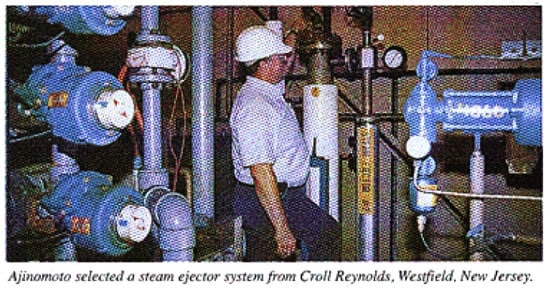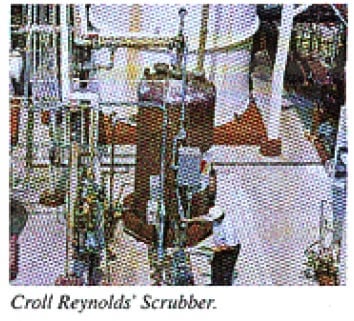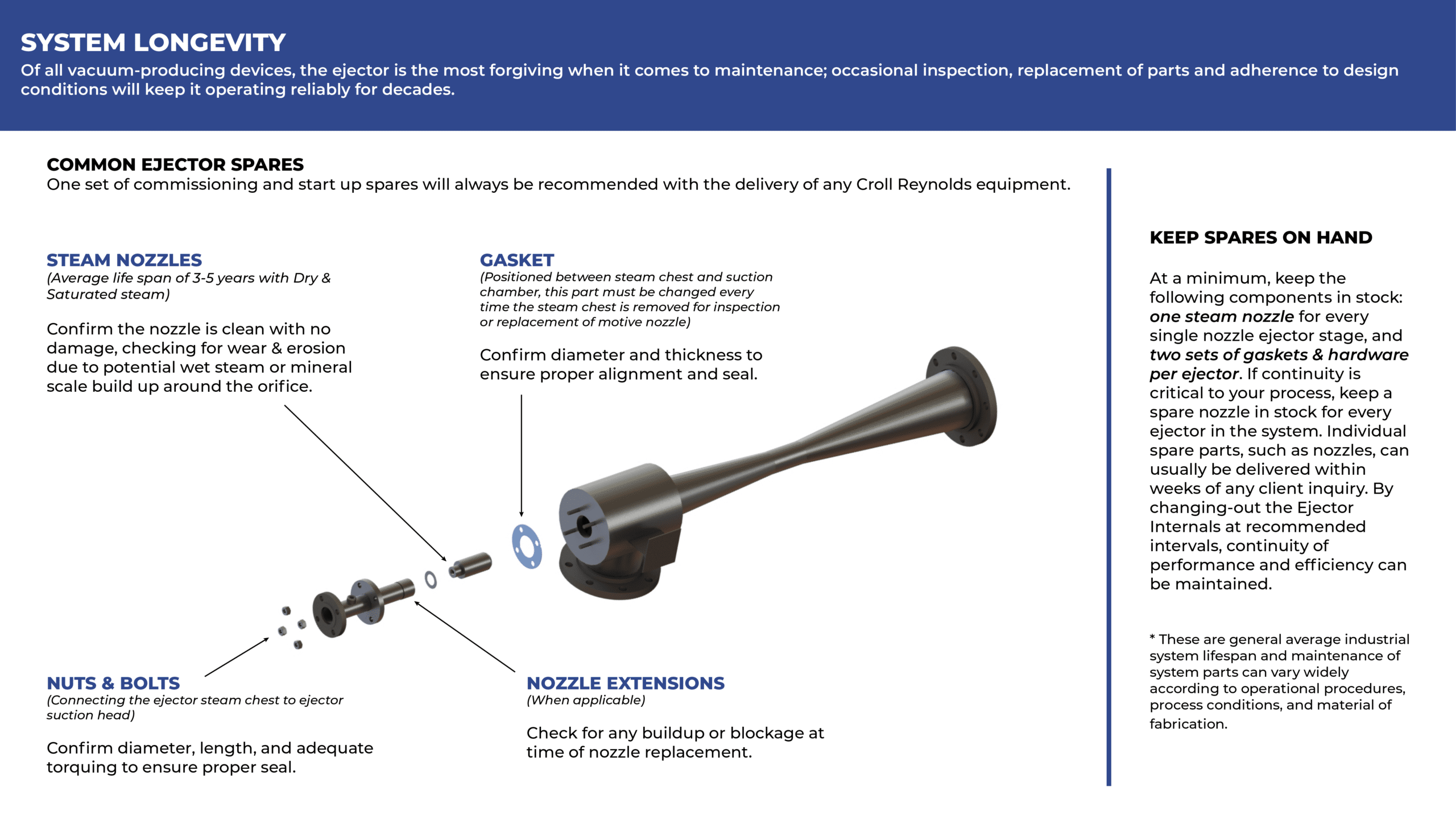The Raleigh, NC plant of Ajinomoto U.S.A. manufactures amino acids, the integral components of protein. All the plant’s amino acids are pharmaceutical grade, in pure crystalline form. They are used in drugs, medical treatments, and as flavor-enhancers and nutritional supplements. Ten individual amino acids are produced, as well as custom-blended mixtures.
 Produced By Fermentation:Â Ajinomoto’s amino acids are produced by a fermentation process. Microorganism cultures are prepared in the microbiology laboratories, then introduced to a glucose bath in fermentation tanks. The bacteria produce amino acids as the broth ferments.
The processes of separation, concentration, and purification are highly complex. High points include cell separation, resin treatment and ultrafiltration. The amino acids are concentrated through several evaporation stages where water is stripped off by boiling under vacuum, at about 65 degrees C, since the high temperatures of ambient boiling would tend to degrade them.
The final processes include crystallization, centrifugation to separate solids and vacuum drying.
Pulling Vacuum: Since the process line went on steam in the early 1980s, an ejector system from Croll Reynolds Co., Inc. has supplied vacuum for a falling-film-evaporator. But vacuum for the final drying stage was originally produced by single-stage liquid ring vacuum pumps.
The liquid ring pumps met their original rating of 75 mm of vacuum. But that wasn’t sufficient to achieve the quick drying cycle required to produce a quality product. Ajinomoto processing engineers considered that 20 mm vacuum would do the required job, but the liquid ring pumps were unable to produce that vacuum. In addition, the pumps were wearing and eroding, with the particles of erosion swept around the liquid ring to do further damage to the vanes.
The Evaluation Process: At this point, the engineering group began to evaluate various options for a replacement dryer vacuum system. Augmentation of the existing system was ruled out, as the existing pumps were wearing, and their inability to achieve desired vacuum was limiting overall capacity.
Three types of equipment were considered: a two-stage steam ejector system, a two-stage mechanical vacuum pump, and a two stage hybrid system of ejector plus liquid ring pump. Evaluation factors included first cost, installation cost, operating cost, maintenance cost, reliability and maintainability.
In most categories the steam ejector were rated higher, with the hybrid system second and the mechanical pump third. The ejectors were considered particularly desirable because of their simple construction with no moving parts.
Since the Raleigh facility has its own captive steam plant to supply various phases of the amino acid process, the steam supply requirement was negligible.
Selecting The Ejector System: The engineering group prepared a performance specification, and Croll Reynolds suggested alternate ejector systems to meet Ajinomoto specifications. The ejector system selected was a two stage with pre-2 intercondensing, all of 304 stainless steel.
Installing The System: The new ejector equipment was installed during a scheduled plant outage. It was located on the roof to accommodate the 33 foot elevation of it liquid ring leg, and specified with automated controls to save time and inconvenience for the operators.
Satisfying Both Management And Customers: In three years of operation the equipment has experienced no basic problems. The only change to system specs was the installation of a booster pump to maintain differential pressure circulating water for pre-and intercondensers.
The equipment is isolated and checked for ultimate vacuum on an annual basis, with satisfactory results.
As anticipated, the ability to draw a higher vacuum has reduced drying time by a significant 25 percent. A process that formerly consumed 24 to 30 hours is now accomplished in 18 to 24 hours.
Faster drying time has improved product quality. In particular, increased production of the more desirable beta crystals has pleased Ajinomoto’s customers.
Scrubber Controls HCI Fumes: A small ejector stage is applied at the plant as part of a dual system combining a venturi (ejector) scrubber with a packed tower for controlling hydrochloric acid fumes venting from three storage tanks.
Produced By Fermentation:Â Ajinomoto’s amino acids are produced by a fermentation process. Microorganism cultures are prepared in the microbiology laboratories, then introduced to a glucose bath in fermentation tanks. The bacteria produce amino acids as the broth ferments.
The processes of separation, concentration, and purification are highly complex. High points include cell separation, resin treatment and ultrafiltration. The amino acids are concentrated through several evaporation stages where water is stripped off by boiling under vacuum, at about 65 degrees C, since the high temperatures of ambient boiling would tend to degrade them.
The final processes include crystallization, centrifugation to separate solids and vacuum drying.
Pulling Vacuum: Since the process line went on steam in the early 1980s, an ejector system from Croll Reynolds Co., Inc. has supplied vacuum for a falling-film-evaporator. But vacuum for the final drying stage was originally produced by single-stage liquid ring vacuum pumps.
The liquid ring pumps met their original rating of 75 mm of vacuum. But that wasn’t sufficient to achieve the quick drying cycle required to produce a quality product. Ajinomoto processing engineers considered that 20 mm vacuum would do the required job, but the liquid ring pumps were unable to produce that vacuum. In addition, the pumps were wearing and eroding, with the particles of erosion swept around the liquid ring to do further damage to the vanes.
The Evaluation Process: At this point, the engineering group began to evaluate various options for a replacement dryer vacuum system. Augmentation of the existing system was ruled out, as the existing pumps were wearing, and their inability to achieve desired vacuum was limiting overall capacity.
Three types of equipment were considered: a two-stage steam ejector system, a two-stage mechanical vacuum pump, and a two stage hybrid system of ejector plus liquid ring pump. Evaluation factors included first cost, installation cost, operating cost, maintenance cost, reliability and maintainability.
In most categories the steam ejector were rated higher, with the hybrid system second and the mechanical pump third. The ejectors were considered particularly desirable because of their simple construction with no moving parts.
Since the Raleigh facility has its own captive steam plant to supply various phases of the amino acid process, the steam supply requirement was negligible.
Selecting The Ejector System: The engineering group prepared a performance specification, and Croll Reynolds suggested alternate ejector systems to meet Ajinomoto specifications. The ejector system selected was a two stage with pre-2 intercondensing, all of 304 stainless steel.
Installing The System: The new ejector equipment was installed during a scheduled plant outage. It was located on the roof to accommodate the 33 foot elevation of it liquid ring leg, and specified with automated controls to save time and inconvenience for the operators.
Satisfying Both Management And Customers: In three years of operation the equipment has experienced no basic problems. The only change to system specs was the installation of a booster pump to maintain differential pressure circulating water for pre-and intercondensers.
The equipment is isolated and checked for ultimate vacuum on an annual basis, with satisfactory results.
As anticipated, the ability to draw a higher vacuum has reduced drying time by a significant 25 percent. A process that formerly consumed 24 to 30 hours is now accomplished in 18 to 24 hours.
Faster drying time has improved product quality. In particular, increased production of the more desirable beta crystals has pleased Ajinomoto’s customers.
Scrubber Controls HCI Fumes: A small ejector stage is applied at the plant as part of a dual system combining a venturi (ejector) scrubber with a packed tower for controlling hydrochloric acid fumes venting from three storage tanks.
 The emissions themselves are not the problem; they are well below prescribed limits. Control was required because chemical attack by the HCL fumes was corroding nearby metallic surfaces.
The fume scrubber works on the principle of an ejector, entraining and scrubbing large volumes of gas without baffles or moving parts. The packed tower works on the counterflow design. The two-stage system is mounted on a sump tank.
By Sieg Sanders, PE, LEM, Maintenance Engineer/Supervisor, Ajinomoto U.S.A. Inc.
The emissions themselves are not the problem; they are well below prescribed limits. Control was required because chemical attack by the HCL fumes was corroding nearby metallic surfaces.
The fume scrubber works on the principle of an ejector, entraining and scrubbing large volumes of gas without baffles or moving parts. The packed tower works on the counterflow design. The two-stage system is mounted on a sump tank.
By Sieg Sanders, PE, LEM, Maintenance Engineer/Supervisor, Ajinomoto U.S.A. Inc.
 Produced By Fermentation:Â Ajinomoto’s amino acids are produced by a fermentation process. Microorganism cultures are prepared in the microbiology laboratories, then introduced to a glucose bath in fermentation tanks. The bacteria produce amino acids as the broth ferments.
The processes of separation, concentration, and purification are highly complex. High points include cell separation, resin treatment and ultrafiltration. The amino acids are concentrated through several evaporation stages where water is stripped off by boiling under vacuum, at about 65 degrees C, since the high temperatures of ambient boiling would tend to degrade them.
The final processes include crystallization, centrifugation to separate solids and vacuum drying.
Pulling Vacuum: Since the process line went on steam in the early 1980s, an ejector system from Croll Reynolds Co., Inc. has supplied vacuum for a falling-film-evaporator. But vacuum for the final drying stage was originally produced by single-stage liquid ring vacuum pumps.
The liquid ring pumps met their original rating of 75 mm of vacuum. But that wasn’t sufficient to achieve the quick drying cycle required to produce a quality product. Ajinomoto processing engineers considered that 20 mm vacuum would do the required job, but the liquid ring pumps were unable to produce that vacuum. In addition, the pumps were wearing and eroding, with the particles of erosion swept around the liquid ring to do further damage to the vanes.
The Evaluation Process: At this point, the engineering group began to evaluate various options for a replacement dryer vacuum system. Augmentation of the existing system was ruled out, as the existing pumps were wearing, and their inability to achieve desired vacuum was limiting overall capacity.
Three types of equipment were considered: a two-stage steam ejector system, a two-stage mechanical vacuum pump, and a two stage hybrid system of ejector plus liquid ring pump. Evaluation factors included first cost, installation cost, operating cost, maintenance cost, reliability and maintainability.
In most categories the steam ejector were rated higher, with the hybrid system second and the mechanical pump third. The ejectors were considered particularly desirable because of their simple construction with no moving parts.
Since the Raleigh facility has its own captive steam plant to supply various phases of the amino acid process, the steam supply requirement was negligible.
Selecting The Ejector System: The engineering group prepared a performance specification, and Croll Reynolds suggested alternate ejector systems to meet Ajinomoto specifications. The ejector system selected was a two stage with pre-2 intercondensing, all of 304 stainless steel.
Installing The System: The new ejector equipment was installed during a scheduled plant outage. It was located on the roof to accommodate the 33 foot elevation of it liquid ring leg, and specified with automated controls to save time and inconvenience for the operators.
Satisfying Both Management And Customers: In three years of operation the equipment has experienced no basic problems. The only change to system specs was the installation of a booster pump to maintain differential pressure circulating water for pre-and intercondensers.
The equipment is isolated and checked for ultimate vacuum on an annual basis, with satisfactory results.
As anticipated, the ability to draw a higher vacuum has reduced drying time by a significant 25 percent. A process that formerly consumed 24 to 30 hours is now accomplished in 18 to 24 hours.
Faster drying time has improved product quality. In particular, increased production of the more desirable beta crystals has pleased Ajinomoto’s customers.
Scrubber Controls HCI Fumes: A small ejector stage is applied at the plant as part of a dual system combining a venturi (ejector) scrubber with a packed tower for controlling hydrochloric acid fumes venting from three storage tanks.
Produced By Fermentation:Â Ajinomoto’s amino acids are produced by a fermentation process. Microorganism cultures are prepared in the microbiology laboratories, then introduced to a glucose bath in fermentation tanks. The bacteria produce amino acids as the broth ferments.
The processes of separation, concentration, and purification are highly complex. High points include cell separation, resin treatment and ultrafiltration. The amino acids are concentrated through several evaporation stages where water is stripped off by boiling under vacuum, at about 65 degrees C, since the high temperatures of ambient boiling would tend to degrade them.
The final processes include crystallization, centrifugation to separate solids and vacuum drying.
Pulling Vacuum: Since the process line went on steam in the early 1980s, an ejector system from Croll Reynolds Co., Inc. has supplied vacuum for a falling-film-evaporator. But vacuum for the final drying stage was originally produced by single-stage liquid ring vacuum pumps.
The liquid ring pumps met their original rating of 75 mm of vacuum. But that wasn’t sufficient to achieve the quick drying cycle required to produce a quality product. Ajinomoto processing engineers considered that 20 mm vacuum would do the required job, but the liquid ring pumps were unable to produce that vacuum. In addition, the pumps were wearing and eroding, with the particles of erosion swept around the liquid ring to do further damage to the vanes.
The Evaluation Process: At this point, the engineering group began to evaluate various options for a replacement dryer vacuum system. Augmentation of the existing system was ruled out, as the existing pumps were wearing, and their inability to achieve desired vacuum was limiting overall capacity.
Three types of equipment were considered: a two-stage steam ejector system, a two-stage mechanical vacuum pump, and a two stage hybrid system of ejector plus liquid ring pump. Evaluation factors included first cost, installation cost, operating cost, maintenance cost, reliability and maintainability.
In most categories the steam ejector were rated higher, with the hybrid system second and the mechanical pump third. The ejectors were considered particularly desirable because of their simple construction with no moving parts.
Since the Raleigh facility has its own captive steam plant to supply various phases of the amino acid process, the steam supply requirement was negligible.
Selecting The Ejector System: The engineering group prepared a performance specification, and Croll Reynolds suggested alternate ejector systems to meet Ajinomoto specifications. The ejector system selected was a two stage with pre-2 intercondensing, all of 304 stainless steel.
Installing The System: The new ejector equipment was installed during a scheduled plant outage. It was located on the roof to accommodate the 33 foot elevation of it liquid ring leg, and specified with automated controls to save time and inconvenience for the operators.
Satisfying Both Management And Customers: In three years of operation the equipment has experienced no basic problems. The only change to system specs was the installation of a booster pump to maintain differential pressure circulating water for pre-and intercondensers.
The equipment is isolated and checked for ultimate vacuum on an annual basis, with satisfactory results.
As anticipated, the ability to draw a higher vacuum has reduced drying time by a significant 25 percent. A process that formerly consumed 24 to 30 hours is now accomplished in 18 to 24 hours.
Faster drying time has improved product quality. In particular, increased production of the more desirable beta crystals has pleased Ajinomoto’s customers.
Scrubber Controls HCI Fumes: A small ejector stage is applied at the plant as part of a dual system combining a venturi (ejector) scrubber with a packed tower for controlling hydrochloric acid fumes venting from three storage tanks.
 The emissions themselves are not the problem; they are well below prescribed limits. Control was required because chemical attack by the HCL fumes was corroding nearby metallic surfaces.
The fume scrubber works on the principle of an ejector, entraining and scrubbing large volumes of gas without baffles or moving parts. The packed tower works on the counterflow design. The two-stage system is mounted on a sump tank.
By Sieg Sanders, PE, LEM, Maintenance Engineer/Supervisor, Ajinomoto U.S.A. Inc.
The emissions themselves are not the problem; they are well below prescribed limits. Control was required because chemical attack by the HCL fumes was corroding nearby metallic surfaces.
The fume scrubber works on the principle of an ejector, entraining and scrubbing large volumes of gas without baffles or moving parts. The packed tower works on the counterflow design. The two-stage system is mounted on a sump tank.
By Sieg Sanders, PE, LEM, Maintenance Engineer/Supervisor, Ajinomoto U.S.A. Inc. 
